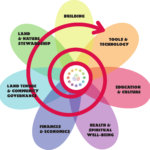What are climate solutions?
I remember the days when climate change was never in the news. Crickets. I’d scan the internet news, looking. Once in a very rare while, there’d be a tiny hint of it, but nothing direct.
I’m referring to the early days of my change-making journey, in the early 2000s. At that time, I felt it was my job to tell people global-warming-global-warming-global-warming at every turn. (It didn’t go down particularly well. I got lots of pushback. “There’s no such thing as global warming” etc.)
Today, it seems like the words “climate change”, together with the drama of the climate-driven disasters we’re seeing, is in the news daily. Some major media sites now have entire sections devoted to climate news: “Climate” appears as a header, just like “Business” and “Entertainment.”
But even today, nearly all this news is still focused on climate-as-a-problem, and climate-as-drama. Very very few of these many articles end with “here’s what you can do.” In that, they portray climate as unsolvable.
But that’s not true.
In December 2020, Dr Joeri Rogelj of Grantham Institute in London and a lead author of the Sixth Assessment of the Intergovernmental Panel on Climate Change made a remarkable statement: “It is our best understanding that, if we bring carbon dioxide [emissions] down to net zero, the warming will level off. The climate will stabilize within a decade or two. There will be very little to no additional warming. Our best estimate is zero.” (1)
What a shift to solutions might look like
I recall noticing a shift media made in their reporting about COVID-19, as well as the shift they made in any reporting that mentioned suicide: They began ending each article with a “what you can do” section. “Here’s the suicide hotline number.” “Here’s what CDC tells you to do about COVID.” They finished the story.
With climate, the media’s not there yet.
My hunch is, they don’t want to tell the full story. They don’t want to speak truth to power.
Because ultimately, the answer to “what can we do about climate change, what will make this quit getting worse, what are climate solutions?” is:
- quit fossils. all of them. as soon as possible.
- boost regeneration, pour resources and effort and focus and public will into regeneration.
- transform consumerism (which means overhauling our current economic systems)
- as we reconstruct new systems, new ways of living, include ALL people.
(Why do I choose these three?)
With a to-do list like that, it’s no wonder there’s no mention of solutions. It flies in the face of 100% of media’s advertisers, their funding base.
That’s why it takes unpaid bloggers like me to say it out loud.
Where to learn more about solutions
In my opinion, each of us who cares about climate should have a doggeared copy of Drawdown: The most comprehensive plan ever proposed to reverse global warming and Regeneration: Ending the climate crisis in one generation , each edited by Paul Hawken. I say doggeared, because it’s not just “having” or “owning” these two books, it’s about using the books, reading them, referring to them, telling all your friends and relatives about them.
Don’t worry. They have lots of pretty pictures.
Each of these books presents, analyzes, and quantifies many, many climate solutions. Choose yours. Figure out how to devote your life to it. Figure out how to fold elements of the others into your lifestyle.
(Um, if you’ve been reading this blog, or coming to my events, I’ve been easing you in this direction for 15+ years)
But these two books aren’t the complete picture. Drawdown addresses the reduction of emissions, and quite a bit of regeneration. Regeneration takes a much deeper look at what needs to happen with respect to carbon sinks. But neither tackle consumerism and the economy that drives it, head on. But neither take on the scope of the new systems/new lifestyles we grassroots people need to shift to (that last point is the reason I initially panned Drawdown when it first came out).
For lifestyle shift, you need something like The Transition Handbook, edited by Rob Hopkins. It’s another pretty-picture book, again packed with possibilities. Simply paging through it will make your heart sing, that there are so many people out there doing such great stuff.
As you’re paging through The Transition Handbook, let your mind wander to the action already taking place around you. You’ll see a picture, or an inset box, and you’ll undoubtedly say to yourself “hey, I saw something like that, right here in my city / my neighborhood.” So, join in. Go meet the people. (they’re your kind of people!) Participate.
With what time?
What better do you have to devote your life to?
Raising kids? Take them alongside as you explore options in your local place. Grandkids, too.
Gotta make a living? Drawdown, Regeneration, and The Transition Handbook point to many, many avenues for making ends meet while doing good. … No, you won’t “make a killing”, but that’s totally the point.
Retired and simplifying your life? This is an essential piece. This is your legacy. This is doing your part toward healing the world you’re leaving to the next generation. Cut other things, so that you have time and energy to focus on this.
In short, climate solutions means shifting and redefining how we live, redefining our relationship with life itself, and redefining what we live for.
Do we have to change our lifestyles?
Yes.
What lifestyle changes?
Reuse. Composting. Being thoughtful about our food, and eliminating food waste. Human-powered transportation, like biking, and walking. Mass transit, which together with human-powered transport means city redesign. Building redesign, for passive heating-cooling, as well as the ways that Christopher Alexander wrote about. City density, to end sprawl, so that we have open land for regeneration / carbon sequestration. Conserving water, and reusing water, especially in SoCalif, because it takes lots of energy to transport/clean/process water. Quitting fossils, all of them (gasoline, natural gas, coal, and all their derivatives). Birth control, and end to forced parenthood, because we need to cap population numbers, and kids-for-those-who-want-them is the easy way to get there. Focus on community, rather than self. Shopping as local as you can, both to ease transportation miles on the goods you use, and to preserve what’s left of our local communities, which means boycotting the massive corporations every time you are able. Nurturing any land you have responsibility for, to make sure it’s sequestering carbon and hosting abundant wildlife. Listening to, and receiving guidance from, indigenous teachers. Teaching kids all of this, while shielding them from the errant influences of mainstream consumerism. Teaching older kids discernment, how to tell right direction from wrong. Saying NO to consumerism, every way we can. Reduce how much you use — of every resource. … and the list goes on …
By the way, this massive shift has a name in some circles: It’s called The Great Turning.
And, once you learn what to look for, elements of The Great Turning are ALL AROUND YOU. They’re right before your eyes (as LA Dept of Transportation transforms Venice Blvd). They’re on your grocery store shelves (how many products now use organic ingredients). They’re in the debates about land use, rematriation. They’re behind many of the attitude changes we see in progressive sectors of society.
They’re even in the news media, drifting along in the background of many stories. Once you know what to look for, you can begin to spot them (although I truly wish — see above — that the media would be much more overt in explaining that THESE ARE THE SOLUTIONS WE NEED RIGHT NOW).
That economy thing
Scroll back up to the bullet points of what we’ve got to do, and you’ll see I pretty much hopped over one of them, a glaring skip.
The economy.
Yup, it’s long overdue for a major overhaul.
Think about how, when your car’s in an accident, everything gets smooshed, warped, distorted. It might be obvious the headlight is broken, the bumper’s falling off. But you might have to look closely to realize that pushing the quarter-panel made the door open funny, and the window doesn’t roll down properly. You’d better have the shop check to see if the frame is warped. That’s the kind of damage The Economy has done to everything around us.
On this blog, The Economy, with leading capital letters, refers to the mainstream economy: stock market, banking systems, loans & debt, consumerism, corporations running politics and undermining democracy, the Fortune 400 wealthiest people on the planet, extreme capitalism “at its finest.” (sarcasm)
The Economy is the driver of go-go-go stress and resultant health-and-mental-health issues, massive numbers of people not being able to make ends meet, local businesses struggling, and a huge array of bad choices.
I don’t have a pretty picture book for the economic aspect of The Great Turning. But in another post I’ll give you some resources toward The Great Turning in the economy.
- Check out my online course Greener or Greenwashing. Learn how to identify products/habits/practices which are false green, “treading water”, keeping us on track for getting worse. Learn how to find true solutions which help repair the damage.
(1) Hawken, P. (2021). Regeneration: Ending the Climate Crisis in One Generation. Zaltbommel, Netherlands: Van Haren Publishing. page 9



